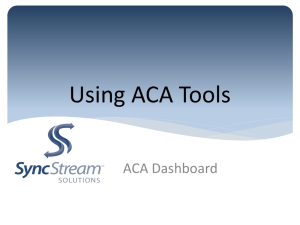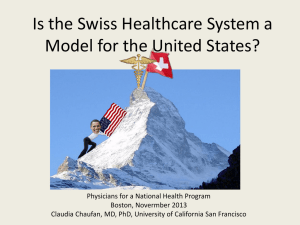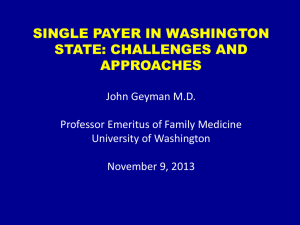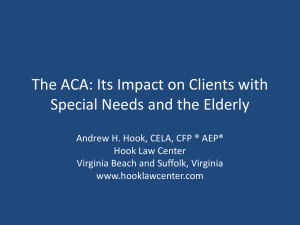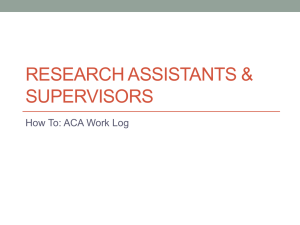College Health Program - Kansas State University
advertisement
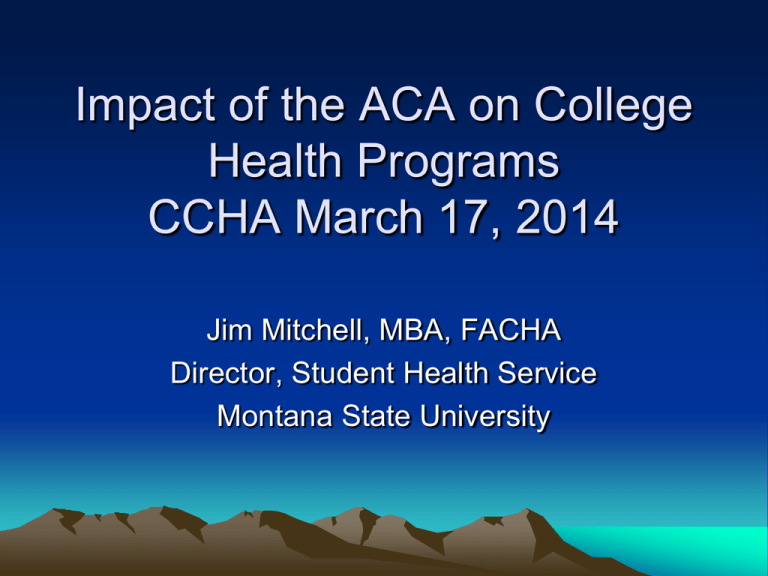
Impact of the ACA on College Health Programs CCHA March 17, 2014 Jim Mitchell, MBA, FACHA Director, Student Health Service Montana State University 2 ACA: The Big Picture • Policy goals: Drastically reduce the number of uninsured and improve quality of insurance coverage • The new landscape of health insurance in 2014 Mandate for most individuals to purchase health insurance if not covered elsewhere Mandates for many employers to offer health insurance have been delayed until 2015 (employers with 100+ employees) and 2016 (employers with 50-99 employees) Insurance marketplaces allow individuals and small businesses to purchase coverage (small business marketplace delayed in many states) Subsidies for low income people with Medicaid expanded in 26 states(incl DC); 19 states not expanding; 6 states are still debating the issue Barriers to coverage (pre-existing condition exclusions, lifetime limits, medical underwriting) are removed Provisions of ACA Implemented Earlier • Extend coverage of young adults on employer plans to age 26 • Preventive care covered with no patient cost sharing • 80% medical loss ratios for individual plans • Ramping up of requirements for student insurance plans; must meet all ACA requirements in 2014 ACA Addresses Quality Issues in Student Plans • Report by NY State Attorney General (2010) Many plans provide dangerously insufficient coverage Many plans return a low percentage of premium in form of benefits Brokers, agents, consultants are often paid exceedingly high commissions Contributions paid by brokers, etc. to colleges and/or their employees leads to a conflict of interest There are often non-standard exclusions (e.g. alcohol related injuries; attempted suicide) Higher Ed Environmental Pressures • Rising Cost/Increasing Student Debt Cost Centers Will Be Critically Reviewed Activities Will Need to Justify Themselves on Basis of Importance to Educational Mission Non-essential Services Will Be Eliminated Outsource Where Possible • Retention and Graduation Rates (particularly in public sector) • Debate about Mission of Higher Education and Learning Outcomes • Disruptive Innovation (MOOCs, on-line education, etc.) • Continuing Concerns over Campus Safety Situation Analysis Pre-ACA (2009) • • • • • Funding stagnation for many college health programs – increasing fee-for-service charges 2009: Less than 10% of students covered by high deductible health plans Trend for adoption of health insurance requirements Dramatic trend for employers to shift cost to employees Trend toward compliance ACHA Ins. Stds. (20% met them), but many substandard plans remain Today (2014) • • • • Medicaid eligibility (where it exists) and subsidies reduce uninsured student population 2014: More than 30% of students covered by high deductible health plans Employers can eliminate coverage for spouses/dependents and have no mandate to subsidize coverage for them. Rate unbundling is a growing trend: Employee + Spouse/Partner + Each Child individually Student plans must meet ACA requirements ACA Impact on SHIBPs and CHPs Student Health Insurance/Benefit Program (SHIBP) College Health Program (CHP) • Individual Mandate – 2014: $95/adult; $47.50/child (up to $285/family) or 1% of family income whichever is greater – 2016: $695/adult; $347.50/child (up to $2085/family) or 2.5% of family income whichever is greater – Exemptions: https://www.healthcare.gov/exemptions/ • • • Ineligible for Medicaid because state did not expand eligibility Financial Hardship -- or cost greater than 8% of family income Ministry sharing plan • • Nominal impact on need for SHIBPs following age 26 mandate. Facilitated trend for employers to adopt high deductible health plans and reduce/eliminate subsidies for spouses/dependents. • 100% preventive care mandate increases challenges to traditional health fee funding for CHPs. ACA Impact on SHIBPs and CHPs • • • Exemption for Student Administrative Health Fees (includes campus health service support and supplemental “bridge” plans) Minimum Essential Coverage – Ends debate for cost v. quality Fully insured plans regulated as individual coverage. • Exemption from Guaranteed Issue/ Guaranteed Renewability No exemption from 80% minimum medical loss ratio (precludes risk dividend accounting, retrospective premium, or other risk sharing) Age rating probably not permissible Benefits must be provided + or – 2% of metal actuarial values (bronze, silver, gold , platinum) No requirement for community rating (e.g., separate rates for undergraduate and graduate students are allowed) Self-Funded Student Health Benefit Plans HHS Certification required for 2015-16 plan year renewals Can fully capture surplus funds. Minimum medical loss ratio and rebate requirement does not apply Should assume required compliance with state mandates, appeals process, and program communications Probably will be able to age rate States may also regulate Other federal statutes continue to apply: Title IX, Section 504, Age Discrimination Act, HIPAA, USIA Regulations for J-1 Visa recipients ACA Impact – Why Student Plans Have a Cost Advantage • No age-based surcharge (same treatment as an employer plan with a young work force) • Ability to rate based on student group experience – including credit for health service and counseling center care • Gatekeeper for preventive care benefits • Self-Funding Permissible Age rating Benefit design flexibility Direct contracting with hospitals/physicians/counselors The Rationale for Student Health Insurance Reasons Not to Provide Reasons to Provide • High Financial Risk in shifting healthcare environment locally and nationally • Community health care provider access • Campus safety – access to psych meds and community mental health resources • Student recruitment/retention asset • Opportunity for community health care provider partnerships/direct contracting • Value for SHIBP v. inconvenience of waiver process (continuing change at national level in ACA, drift from core education mission) • ACA individual mandate is sufficient – no additional institutional or campus safety need or responsibility • ACA individual mandate addresses the impact on uncompensated care within local communities • Highly transitory, non-residential campus • Urban area, college population is not highly visible. • • • • Employer cost shifting No exchange subsidies for employer-plan eligible Out-of-state students International students ACA Impact – Insurance Choices Student Classification Montana Residents – Dependent on Parents Insurance Choices Notation • • Parent’s Insurance Not eligible for MT Marketplace Subsidies Trend for employers to adopt high deductible health plans and discontinue subsidy of dependent coverage • • Ineligible for Medicaid w/o children Eligible for MT Marketplace Subsidy at $11,500 2014 Annual Gross Income for an individual • Insurance exchange includes surcharge for young adults • Bozeman Resident (age 21-24) $235 for Gold ($1,500 deductible) $198 for Silver ($3,000 deductible) $161 for Bronze ($5,000 deductible) • Eligible for Employer-Sponsored Coverage Montana Residents – Independent of Parents $168 Student plan ($300 ded.) (Gold) • Non-Resident Students • • International Students Graduate Students/Teaching Assistants/Researchers • Most will be ineligible for insurance marketplace subsidies Lowest cost exchange options will feature limited provider networks • ACA mandate depends on “non-resident alien tax status” ACA compliant coverage required • Eligible for Insurance Marketplaces (no subsidies) • 5 year waiting period for Medicaid See Above • Emergency access only in Montana High deductible health plans ACA Employment Status 12 The Future of College Health Programs A broad spectrum of strategic options with multiple permutations. . . Status Quo Back to Basics Hope enrollment growth continues to fund on-campus services Discontinue prefunding of oncampus services -- lease facilities to health care providers OR Discontinue oncampus health services altogether Continue to make changes when there is a clear path Transition to Insurance Billing Shift funding from health fees to feeforservice/insurance Reimbursement Obtain statutory change for secondary Payor status for health fees Advanced SHIBP Management • Self-Funding • Direct Contracting • Program Marketing Triple Option Program Provide three insurance options and shift funding of on-campus services primarily to insurance capitation 13 Triple Option • Comprehensive Program (60% of students) Self-funded Benefit Plan SHS and Counseling Capitation • Supplemental Care Plan (Students with high deductible plans) (20% of students) SHS and Counseling Capitation Limited Rx, long-term counseling, diagnostic lab/imaging Excludes preventive care covered by insurance • Students with Gold/Platinum Level Coverage (20% of students) Students pay office visit/counseling co-pays specified by insurance/Medicaid 100% coverage for preventive care Health promotion and public health functions funded through pre-paid fees or institutional allocation Opportunities • Move Back to Capitation • Expand to Provide Services to Faculty/Staff+Dependents • Community Partnerships • Experiment with New Organizational Structures/Technology • Elimination of Current Silos “The pessimist sees difficulty in every opportunity. The optimist sees the opportunity in every difficulty.” --Winston Churchill 16 Questions and Discussion 17


